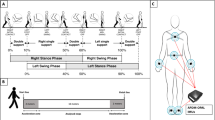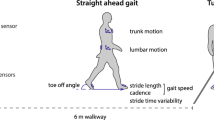Abstract
Background
This study aimed to determine the relationships between subjective validated patient-reported outcomes and health-related quality of life, to objective gait characteristics in patients with foot–ankle conditions. Objective gait characteristics were obtained using a wearable foot inertial-sensor device as well as by assessing the relationships between spatiotemporal or gait parameters by analyzing the inter-metric correlations.
Methods
Fifty-two patients with foot–ankle conditions (37 women/15 men, aged 21–75 years) were included in this study. Clinical assessments, including evaluations of validated patient-reported outcomes using visual analog scale foot and ankle score, health-related quality of life using validated Short Form-36, and gait characteristics using a wearable foot inertial-sensor device, were performed and recorded for each patient.
Results
A significant negative correlation was observed between the physical component summary (PCS) and maximal cadence (r = − 0.308, P = 0.025). Significant positive correlations were noted between mean walking speed and mean cadence (r = 0.776, P < 0.001) and between maximal walking speed and mean step length (r = 0.498, P < 0.001). Significant negative correlations were found between the mean cadence and mean step length (r = − 0.491, P < 0.001) and between maximal cadence and mean step length (r = − 0.355, P = 0.009).
Conclusions
Cadence is an important objective spatiotemporal parameter to assess in foot and ankle patients as it relates well to outcome, with a significantly negatively correlation to subjectively reported PCS in health-related quality of life. Based on inter-metric relationships, an increased cadence might be used to maintain walking speed as a compensatory mechanism in patients with foot–ankle conditions.
Similar content being viewed by others
References
Angthong C (2016) Validity and reliability of Thai version of the foot and ankle outcome score in patients with arthritis of the foot and ankle. Foot Ankle Surg 22:224–228
SooHoo NF, Shuler M, Fleming LL, American Orthopaedic Foot and Ankle Society (2003) Evaluation of the validity of the AOFAS clinical rating systems by correlation to the SF-36. Foot Ankle Int 24:50–55
Richter M, Zech S, Geerling J, Frink M, Knobloch K, Krettek C (2006) A new foot and ankle outcome score: questionnaire based, subjective, visual-analogue-scale, validated and computerized. Foot Ankle Surg 12:191–199
American Orthopaedic Foot and Ankle Society (AOFAS) (ed) (2003) Symposium X—outcomes assessment in foot and ankle surgery—What instrument should we use?
Rosenlund S, Holsgaard-Larsen A, Overgaard S, Jensen C (2016) The gait deviation index is associated with hip muscle strength and patient-reported outcome in patients with severe hip osteoarthritis: a cross-sectional study. PLoS ONE 11:e0153177
Van der Linden ML, Hooper JE, Cowan P, Weller BB, Mercer TH (2014) Habitual functional electrical stimulation therapy improves gait kinematics and walking performance, but not patient-reported functional outcomes, of people with multiple sclerosis who present with foot-drop. PLoS ONE 9:e103368
Van Hoeve S, de Vos J, Verbruggen JP, Willems P, Meijer K, Poeze M (2015) Gait analysis and functional outcome after calcaneal fracture. J Bone Joint Surg Am 97:1879–1888
Angthong C, Chernchujit B, Suntharapa T, Harnroongroj T (2011) Visual analogue scale foot and ankle: validity and reliability of Thai version of the new outcome score in subjective form. J Med Assoc Thai 94:952–957
Jirarattanaphochai K, Jung S, Sumananont C, Saengnipanthkul S (2005) Reliability of the medical outcomes study short-form survey version 2.0 (Thai version) for the evaluation of low back pain patients. J Med Assoc Thai 88:1355–1361
Maenaka K (2008) MEMS inertial sensors and their applications. In: 2008 5th International conference on networked sensing systems, Kanazawa, pp 71–73. http://dx.doi.org/10.1109/INSS.2008.4610859
Schmitt D, Vap A, Queen RM (2015) Effect of end-stage hip, knee, and ankle osteoarthritis on walking mechanics. Gait Posture 42:373–379
Tudor-Locke C, Rowe DA (2012) Using cadence to study free-living ambulatory behaviour. Sports Med 42:381–398
Aguilar-Ferrándiz ME, Moreno-Lorenzo C, Matarán-Peñarrocha GA, García-Muro F, García-Ríos MC, Castro-Sánchez AM (2014) Effect of a mixed kinesio taping-compression technique on quality of life and clinical and gait parameters in postmenopausal women with chronic venous insufficiency: double-blinded, randomized controlled trial. Arch Phys Med Rehabil 95:1229–1239
Schroeder JB (2009) Case 2: a gait to remember. Paediatr Child Health 14:189–192
Cadenas-Sanchez C, Arellano R, Vanrenterghem J, López-Contreras G (2015) Kinematic adaptations of forward and backward walking on land and in water. J Hum Kinet 49:15–24
Bayle N, Patel AS, Crisan D, Guo LJ, Hutin E, Weisz DJ, Moore ST, Gracies JM (2016) Contribution of step length to increase walking and turning speed as a marker of Parkinson’s disease progression. PLoS ONE 11:e0152469
Author information
Authors and Affiliations
Corresponding author
Ethics declarations
Conflict of interest
The first author reports personal fees from Amgen, Device Innovation, Phoenix surgical equipment (Thailand), Novatec Healthcare (Thailand), Pfizer, Eisai (Thailand), Symgens, Smith & Nephew, and Bangkok Unitrade outside the submitted work. The second author reports grants from Acumed, grants from Zimmer, grants from Bioventus, from null, grants from Wright medical, grants from Arthrex, grants from Synthes, grants from Ferring, and grants from Amniox, outside the submitted work.
Rights and permissions
About this article
Cite this article
Angthong, C., Veljkovic, A. Relationships among subjective patient-reported outcome, quality of life, and objective gait characteristics using wearable foot inertial-sensor assessment in foot–ankle patients. Eur J Orthop Surg Traumatol 29, 683–687 (2019). https://doi.org/10.1007/s00590-018-2346-0
Received:
Accepted:
Published:
Issue Date:
DOI: https://doi.org/10.1007/s00590-018-2346-0




